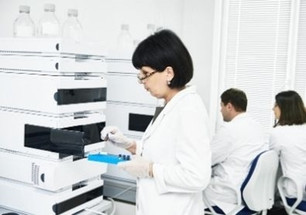Posted by Chrom Tech on 15th Oct 2025
Inline Filters vs. Guard Columns for HPLC
Protecting Your HPLC Columns: The Role of Filters and Guard Columns
In high-performance liquid chromatography (HPLC), filters such as inline filters, pre-column filters, and guard columns play an essential role in preventing column damage and extending column lifespan. Over time, column performance can degrade due to the buildup of irreversibly bound compounds and particulates on the frit. These contaminants often originate from mobile phase buffers, pump seal wear, or sample particulates—all of which can lead to increased backpressure or complete column blockage. Proper filtration safeguards your column investment by removing particulates before they reach the analytical column.
Inline Filters vs. Guard Columns in HPLC
Inline Solvent Filters
Inline solvent filters are designed to trap particles within the mobile phase before they can cause damage downstream. They are typically installed between the pump and the injector, serving two key purposes:
- Prevent particulate contamination of the mobile phase
- Protect pump rotor seals from debris caused by seal wear
Because inline filters are located in the low-pressure region of the HPLC system, void volume is not a critical concern. These filters act as the system’s first line of defense, ensuring clean solvent delivery and reducing premature wear on mechanical components.
Pre-Column Filters
Pre-column filters are a cost-effective solution for protecting the HPLC column from particulates and debris introduced during sample injection. Installed between the injector and the analytical column, these filters prevent clogging and extend column lifetime.
Pre-column filters are typically union-style connections with replaceable frits of defined porosity. To minimize chromatographic distortion, the internal swept volume should be kept as small as possible. High-quality pre-column filters are engineered for ultra-high-pressure compatibility, offering pore sizes down to 0.2 µm while maintaining minimal internal volume to prevent peak broadening.
Guard Columns
A guard column is a short, replaceable cartridge installed directly before the analytical column. Its dual protective functions include:
- Trapping particulate matter at the inlet frit to prevent clogging
- Capturing strongly or irreversibly bound compounds using stationary phase chemistry that matches the main analytical column
While guard columns are more expensive than inline or pre-column filters, they offer the most comprehensive protection—safeguarding both the column frit and the stationary phase from contamination and chemical fouling. This makes them especially beneficial for methods involving dirty samples, complex matrices, or long analytical runs.
Choosing the Right Column Protection Solution
Each filtration component in an HPLC system plays a unique role:
- Inline filters protect the system pump and solvent path.
- Pre-column filters protect the column from particulates immediately after sample injection.
- Guard columns protect both the column frit and the stationary phase from fouling and irreversible adsorption.
For maximum protection and performance, Chrom Tech recommends combining these solutions in your HPLC setup. Proper filtration not only extends column life but also enhances analytical reproducibility and reduces system downtime.
Explore Chrom Tech’s full range of chromatography supplies, including inline filters, pre-column filters, and guard columns designed for every system configuration.
Frequently Asked Questions About HPLC Filters and Guard Columns
What is the difference between an inline filter and a pre-column filter?
Inline filters are installed between the pump and injector to protect the pump seals and solvent path, while pre-column filters are positioned before the analytical column to capture debris from injected samples and protect the column frit.
When should I use a guard column instead of a pre-column filter?
Use a guard column when method reproducibility and stationary phase protection are critical. Guard columns replicate the chemistry of the analytical column and trap compounds that could otherwise irreversibly bind to the main column.
How often should I replace my HPLC filters or guard column?
Replacement frequency depends on sample cleanliness, solvent quality, and system use. As a rule, replace filters or guard cartridges when backpressure increases or when peak shape or retention time shifts indicate contamination.

